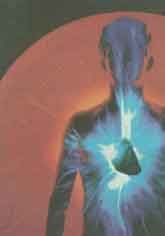
Ryan was playing on his computer when the telephone rang. He died immediately from shock at just 19 years old. Lisa, 27, was found dead in her bed after her alarm clock went off. And 12-year-old Alexander died while playing cricket at school.
All three were apparently healthy and yet they died with little or no warning. Around the country, eight equally healthy people under 35 die the same way every week. The condition claiming their lives is commonly known as Sudden Adult Death Syndrome but, because we now know it also affects young children, it is referred to as Sudden Arrhythmic Death Syndrome (SADS). Arrhythmia refers to a disturbance in the heart’s rhythm.
Although it is not a definite cause, there is an undeniable link between SADS and exercise – many victims were either exercising at the time of their deaths or physically fit.
“Exercise puts added strain on a heart with an irregular heartbeat,” says Judy O’Sullivan, a cardiac nurse at the British Heart Foundation.
“It goes into an irregular rhythm and the amount of blood is no longer adequate to keep the body going. There are often no symptoms apart from the occasional blackout or dizziness.”
Electrical abnormality
Research into the syndrome is often stumped by the mysterious circumstances surrounding it and there are believed to be many possible causes. They are divided into two groups: channelopathies and cardiomyopathies.
Channelopathies are a group of rare disorders that affect the electrical system of the heart, the most common being a hereditary defect called Long QT. Cardiomyopathies are heart muscle diseases that are usually inheritable. The most common of these is hypertrophic cardiomyopathy (HCM), in which a thickened heart wall muscle stops the heart beating. It is believed that up to 10,000 people in Britain have HCM. For some, it may never affect their health. For others, it is fatal.
Channelopathies are particularly hard to diagnose, O’ Sullivan says, because the electrical abnormality disappears once the heart stoops.
“Their heart appears structurally normal,” she explains.
“Which means the cause of death isn’t obvious.
Until recently, it has been difficult for coroners to even report SADS.”
Mandatory heart scans
Alison Cox is chief executive of the charity Cardiac Risk in the Young (CRY). She says we need a way to check for these heart irregularities. But can we predict a syndrome that has no obvious symptoms and claims lives within seconds? Cox believes a mandatory heart scan for young people will pick up defects early enough to treat them.
“When teenagers have their BCG vaccinations, we want them to have an ECG (electrocardiogram),” she says.
“It will get them thinking about their hearts from a young age and may help tackle other problems such as obesity. The cutting edge of grief is when you have a healthy and happy 16-year-old who suddenly drops dead.”
For many families who have lost a loved one, SADS can bring added distress. Many of the various heart problems that led to premature deaths are genetic.
“It’s a frightening time for parents. One of their children drops dead and they are told that it could potentially affect the rest of their family,” O’ Sullivan says.
“But if this happens, the immediate family will have a genetic screening. Unfortunately, I don’t think we could make these tests available for every person in the country. It’s only when we know there is a definite risk.”
But Cox says this attitude isn’t enough.
“We need a way to check everyone. These children are our future and the 400 deaths every year are being ignored.”
Sports Stars
Manchester City and Cameroon footballer Marc-Vivien Foe was 28 years old when de died from SADS. He was playing in an international match on June 26, 2003, and collapsed on the pitch. Foe was at the peak of his career and obviously fit and healthy but an autopsy failed to confirm a cause of death. A second autopsy two weeks later found that he had hypertrophic cardiomyopathy. He isn’t the only sportsman to die from SADS. Robert Hayley, a 17-year-old rower, died shortly after competing with Sir Steve Redgrave. Swimmer Laura Moss from the Olympic Swim 2000 squad was 13 when she died at a school swimming gala and 22-year-old cyclist Adrian Hawkins died weeks after being short-listed for the Barcelona Olympics cycling squad.
Current Action
A National Service Framework (NSF) is a Government policy that sets long-term strategies for improving specific areas of care. A year ago, it was agreed that, after a death or a diagnosis of a heart irregularity, all immediate family members would be given a heart screening. But, according to CRY, no significant progress has been made and many families still haven’t had this screening.






